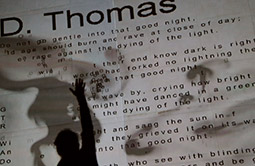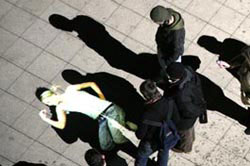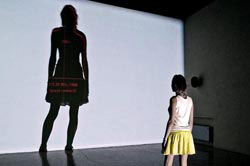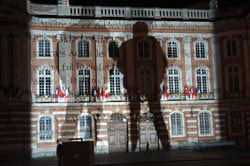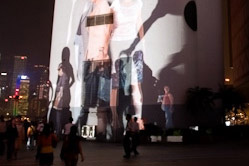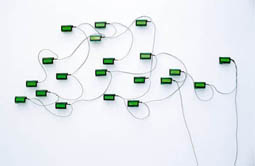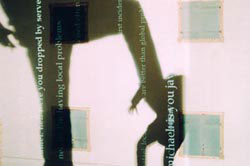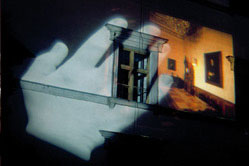Airborne Newscasts
Relational Architecture 20, 2013
"Airborne Newscasts" (Relational Architecture 20) is an interactive installation originally commissioned by the Chrysler Museum of Art to transform Norfolk, Virginia’s public space into a poetic shadow play. By blocking the light of two projectors, participants cast their shadows onto a 900-square-metre wall, and these shadows are tracked by computerized surveillance systems. Out of the shadows emanate billowing smoke which is mapped onto the wall, slowly accumulating within it. Turbulent clouds of live newscasts evaporate from the “heat” of the tracked bodies.
View details.
View details.
Sandbox
Relational Architecture 17, 2010
“Sandbox” (Relational Architecture 17) is a large-scale interactive installation created originally for Glow Santa Monica. The piece consists of two small sandboxes where one can see tiny projections of people who are at the beach. As participants reach out to touch these small ghosts, a camera detects their hands and relays them live to two of the world's brightest projectors, which hang from a boom lift and which project the hands over 8,000 square feet of beach. In this way people share three scales: the tiny sandbox images, the real human scale and the monstrous scale of special effects.
View details.
View details.
Solar Equation
Relational Architecture 16, 2010
"Solar Equation" is a large-scale public art installation that consists of a faithful simulation of the Sun, 100 million times smaller than the real thing. Commissioned by the Light in Winter Festival in Melbourne, the piece features the world’s largest spherical balloon, custom-manufactured for the project, which is tethered over Federation Square and animated using five projectors. The solar animation on the balloon is generated by live mathematical equations that simulate the turbulence, flares and sunspots that can be seen on the surface of the Sun. This produces a constantly changing display that never repeats itself, giving viewers a glimpse of the majestic phenomena that are observable at the solar surface and that only relatively recent advances in astronomy have discovered. Using an iPhone, iPod touch or iPad, people may disturb the animations in real-time and select different fluid dynamic visualizations.
View details.
View details.
Under Scan
Relational Architecture 11, 2005
"Under Scan" (Relational Architecture 11) is a public art installation based on self-representation. Thousands of "video-portraits" taken in Derby, Leicester, Lincoln, Northampton and Nottingham are projected onto the ground; at first, the portraits are not visible because the space is flooded by white light coming from a high-powered projector. As people walk around the area, their shadows are cast on the ground, revealing the video-portraits in short sequences.
View details.
View details.
Frequency and Volume
Relational Architecture 9, 2003
"Frequency and Volume" (Relational Architecture 9) enables participants to tune into and listen to different radio frequencies by using their own bodies. A computerized tracking system detects participants' shadows, which are projected on a wall of the exhibition space. The shadows scan radio waves with their presence and position, while their size controls the volume of the signal. The piece can tune into any frequency between 150 kHz and 1.5 GHz, including air traffic control, FM, AM, short wave, cellular, CB, satellite, wireless telecommunication systems and radio navigation. Up to forty-eight frequencies can be tuned simultaneously and the resulting sound environment forms a composition controlled by people's movements.
View details.
View details.
Amodal Suspension
Relational Architecture 8, 2003
“Amodal Suspension" (Relational Architecture 8) is a large-scale interactive installation in which people send short text messages to each other using a cell phone or web browser. However, rather than being sent directly, the messages are encoded as unique sequences of flashes with twenty robotically-controlled searchlights, not unlike the patterns that make up Morse code. Messages "bounce" around from searchlight to searchlight, turning the sky into a giant switchboard.
View details.
View details.
Two Origins
Relational Architecture 7, 2002
“Two Origins” (Relational Architecture 7) is an intervention in which the emblematic Place du Capitole in Toulouse was transformed by a projection of The Book of Two Origins, a 13th-century heretical manuscript compiling the theological beliefs of the dualist cathars. Once a vibrant community in several regions of Europe, the believers in the two origins of the Universe were virtually annihilated by the brutal crusades that gave birth to the Inquisition and France's expansion. The texts are illegible since they are projected overlapping each other on the same façade from two distant projectors; only when passers-by block one text with their bodies is it possible to read the other text inside their shadow.
View details.
View details.
Body Movies
Relational Architecture 6, 2001
"Body Movies" transforms public space with interactive projections measuring between 400 and 1,800 square metres. Thousands of photographic portraits, previously taken on the streets of the host city, are shown using robotically controlled projectors. However the portraits only appear inside the projected shadows of the passersby, whose silhouettes can measure between two and twenty-five metres depending on how close or far away they are from the powerful light sources positioned on the ground.
View details.
View details.
33 Questions per Minute
Relational Architecture 5, 2000
"33 Questions Per Minute" (Relational Architecture 5) consists of a computer program which uses grammatical rules to combine words from a dictionary and generate 4.7 trillion unique, fortuitous questions. The automated questions are presented at a rate of 33 per minute—the threshold of legibility. The system will take over 271,000 years to ask all possible questions.
View details.
View details.
Re:Positioning Fear
Relational Architecture 3, 1997
"Re:Positioning Fear" (Relational Architecture 3) was a large-scale installation on the Landeszeughaus military arsenal with a "teleabsence" interface of projected shadows of passers-by. Using tracking systems, the shadows were automatically focused and generated sounds. A real-time IRC discussion about the transformation of the concept of "fear" was projected inside the shadows; the chat involved 30 artists and theorists from 17 countries.
View details.
View details.
Displaced Emperors
Relational Architecture 2, 1997
"Displaced Emperors" (Relational Architecture 2) was an interactive installation that used an "architact" —architecture meets haptics— interface to transform the facade of the Habsburg Castle in Linz, Austria. Wireless 3D sensors calculated where participants pointed to on the façade and a large animated projection of a hand was projected at that location. As people on the street "caressed" the building, they could reveal the interiors of the Habsburg residence in Mexico City, Castillo de Chapultepec.
View details.
View details.
